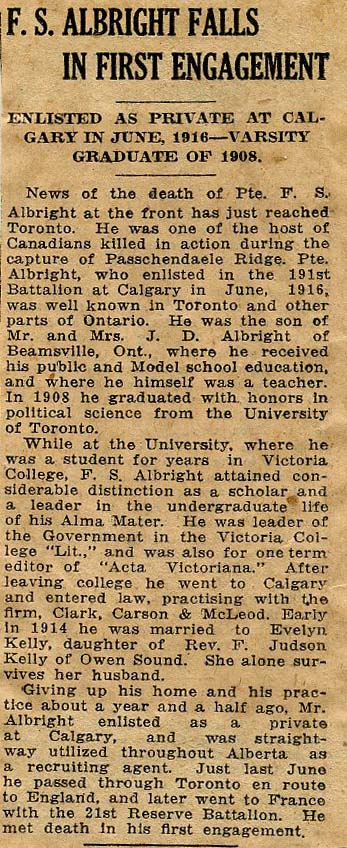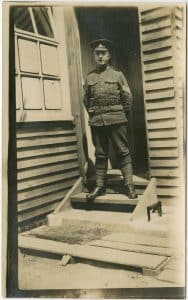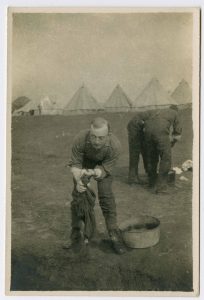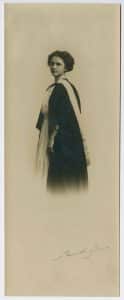Frederick Stanley Albright was born in Beamsville, Ontario, on March 23, 1883. After his childhood in rural Ontario, Frederick moved to Toronto where he attended Victoria College, University of Toronto, where he received a Bachelor of Arts degree in Political Science in 1908. At university he met Evelyn Kelly, born on November 13, 1889, of Owen Sound, Ontario. She graduated with a Bachelor of Arts degree in English and History in 1912.
After receiving his degree, Frederick moved to Calgary in 1909 where he started as a student-at-law with the Walsh, McCarthy, Carson firm (later Macleod Dixon LLP, later Norton Rose LLP) on September 8, 1909. Senior partner, William Leigh Walsh, once described Frederick as “one of the brightest articling students he had ever seen.” As a student, Frederick kept interesting company. He shared a living quarters with future Alberta Premier, John Brownlee and future Chief Justice of Alberta, Clinton Ford. He also, on numerous occasions, interacted with R.B. Bennett, prominent Calgary lawyer and future a Prime Minister of Canada.
Frederick seemed to settle nicely into his new surroundings. In one of nearly 600 letters he exchanged with Evelyn, he described the openness and beauty of the Alberta as having a “peculiar[ly] exhilarating quality that only the West can give.” Frederick wrote in another letter that, in his opinion, “ultimately Alberta will be the banner Prairie province and it’s good to see a place in the making.” He also sent Evelyn postcards from the first Calgary Stampede in 1912, and expressed the view that it was “a wonderful realistic indication of the life of the early days.” Despite keeping in regular contact with Evelyn, he greatly missed her. He queried in one letter, “I wonder if you are lonely for me tonight as I am for you.”
Though he returned to Ontario for occasional visits, he knew Calgary was the place to call home. Frederick wrote to Evelyn about the property and investment opportunities he saw in the city. However, for some reason he did not invest in those early opportunities that were paying off handsomely for some of his friends who were less conservative in nature.
After completing his articles, Frederick Albright was admitted to the Law Society of Alberta on September 16, 1912 and he continued to practice with the Macleod firm. Frederick and Evelyn were writing married in June of 1914, and settled in Calgary.
While honeymooning in England, the Great War erupted in August 1914. Upon returning to Calgary, it was clear that a normal life was not going to be possible given what was happening across the Atlantic. Reports from the war were swirling throughout Calgary and the Albrights regularly received news reports about friends who had been injured or killed oversees. In 1916, after about two years of conflict, Frederick decided to enlist as a Private. He was initially sent to England and then later to France. He was killed in action during the Battle of Passchendaele on October 26, 1917. The Battle of Passchendaele, part of the third Battle of Ypres, was a major offensive during the First World War. Fought between the Allies and the German Empire, it took place on the Western Front from July to November 1917. Known for the heavy rains and mud that bogged down all troop movements, the first Battle of Passchendaele took the lives of nearly 15,600 Canadian troops. Frederick Albright was killed during his first frontline action.
During his absence oversees, the Albrights continued to exchange letters. The last letter Frederick sent was dated October 19-20, 1917. Evelyn’s last letters were returned unopened with the stamp “Killed in Action” on the envelope.
She received official notification of her husband’s death via telegram on November 10, 1917, which simiply said, “4204 deeply regret to inform you eight nine five one seven three PTE Frederick Stanley Albright infantry officially reported killed in action between Oct twenty third and twenty six nineteen seventeen.”
According to an editorial in the Calgary Daily Herald following his death, Frederick enlisted “not because he loved war, not because the life of a soldier appealed to him, not because he did not have reasons aplenty for remaining home; he enlisted purely out of a sense of duty, because he felt he was called to don the uniform to serve his country and his God.”
Another Alberta lawyer, Sydney Raymond Vallance, was injured during the Battle of Passchendaele. In 1918, Sydney Vallance wrote to Charles Adams, Secretary at the Law Society of Alberta, indicating that he was receiving medical clearance and would hopefully be returning to Alberta, and that his “good fortune was due to a dose of gas at Passchendaele, received about the same day that F.S. Albright was killed.”
After receiving notification of the death of her husband, the life Evelyn had imagined was forever altered. She was young, well-educated and intellectual. This fact was evident from many of the letters she exchanged with her husband on topics that included feminism, race, eugenics, health, religious, social and political concerns. In one letter she wrote, “what makes me mad, just hot, fighting mad, is for a man or a boy to claim that because he is a man he should vote, because I am a woman, I should not vote.” She continued, “that he has any more interest in government then I have I resent and deny, what is implied in that contention, that is the superiority of the man over the woman.”
Following Frederick’s enlistment in the army, Evelyn was accepted as a student-at-law with the same firm that her husband had practiced with. She completed her articles with A.H. Clarke and was admitted to the Law Society of Alberta on October 16, 1919. She was only the second woman to be admitted to the Law Society of Alberta. However, Evelyn Albright never practiced law. After her admission she returned to Ontario and joined the English Faculty at the University of Western Ontario as its first female instructor. She later earned a Master’s degree and taught there until her retirement in 1951.
Evelyn never remarried and rarely spoke of her husband. She passed away at the age of 89 on April 24, 1979. The nearly 600 letters exchanged between the young couple during their courtship, marriage and his military service were donated to the University of Western Ontario. They were organized and transcribed by Lorna Brooke, a library assistant at the university. The letters can be accessed at www.echoinmyheart.ca.
*All the letters quoted in this article can be found at www.echoinmyheart.ca.






